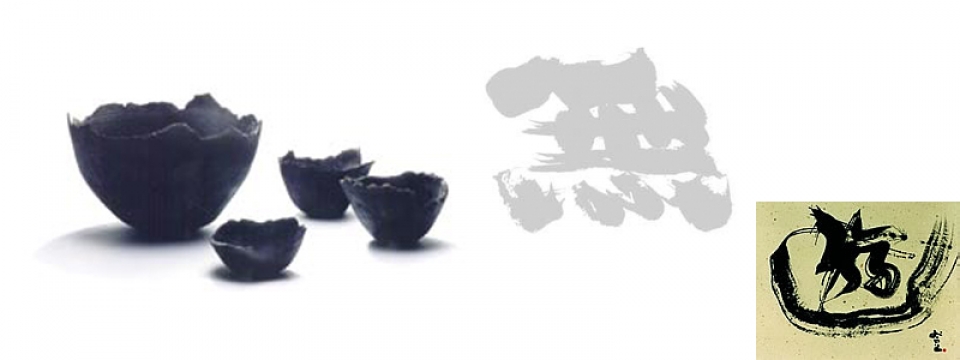Art 書・陶

絵を描くように字を書く。
遊・楽・乱・風・空・光・・・
字を書くだけで情景が描ける。
でも「無」を書いた時、はたと困った。
何もないという意味にしては字ががっしりしすぎている。四本の柱に屋根までついて・・・
何度も「無」を書いているうちに、ふっと情景が見えた。これは、おみこしだ。
おみこしの中は空っぽ、何もない。
この空っぽの中にたくさんの大切なものがある!大勢の人々がワッショイ、ワッショイ「おみこし」をかついでいる。
それが「無」なのだ。
ならば「無」の境地とは、お祭りさわぎの絶好調の時の気分なのかな。うん、わかるような、わからないような・・・。
字はますます面白い。
遊・楽・乱・風・空・光・・・
字を書くだけで情景が描ける。
でも「無」を書いた時、はたと困った。
何もないという意味にしては字ががっしりしすぎている。四本の柱に屋根までついて・・・
何度も「無」を書いているうちに、ふっと情景が見えた。これは、おみこしだ。
おみこしの中は空っぽ、何もない。
この空っぽの中にたくさんの大切なものがある!大勢の人々がワッショイ、ワッショイ「おみこし」をかついでいる。
それが「無」なのだ。
ならば「無」の境地とは、お祭りさわぎの絶好調の時の気分なのかな。うん、わかるような、わからないような・・・。
字はますます面白い。
「器用より不器用がいい」と言ってくれた人がいた
誰にもつくれない形 二度とない形
土がそのまま生きている
その誰にも支配されない激しさとやさしさが好き
誰にもつくれない形 二度とない形
土がそのまま生きている
その誰にも支配されない激しさとやさしさが好き
I write characters as if I am painting.
遊play 楽 enjoy 乱 out of order 風 wind 空 sky 光 light…
I picture these images when I “paint” characters.
I was at a loss, however, in writing the character 無, which appeared too sturdy for its meaning of “nothing,” with corner posts, four legs, and even a roof on top.
I continued writing the character, 無, many times, when suddenly an image came to mind. This character illustrates mikoshi, a portable shrine, which has nothing inside, is empty. There are so many essentials in this emptiness!
Many people carry a mikoshi while chanting “washoi, washoi” (heave ho, heave ho).
This is a representation of “無.”
If so, does it mean a mental state of “無” attained at the peak of exuberant festivities? Maybe, maybe not….
Characters became more and more interesting.
Someone told me, “Being clumsy is more precious than being skillful.”
Shapes made by no one else,
Shapes never to appear again,
Soil, unchanged, retains its essence.
I like such intensity and tenderness that cannot be overcome.
遊play 楽 enjoy 乱 out of order 風 wind 空 sky 光 light…
I picture these images when I “paint” characters.
I was at a loss, however, in writing the character 無, which appeared too sturdy for its meaning of “nothing,” with corner posts, four legs, and even a roof on top.
I continued writing the character, 無, many times, when suddenly an image came to mind. This character illustrates mikoshi, a portable shrine, which has nothing inside, is empty. There are so many essentials in this emptiness!
Many people carry a mikoshi while chanting “washoi, washoi” (heave ho, heave ho).
This is a representation of “無.”
If so, does it mean a mental state of “無” attained at the peak of exuberant festivities? Maybe, maybe not….
Characters became more and more interesting.
Someone told me, “Being clumsy is more precious than being skillful.”
Shapes made by no one else,
Shapes never to appear again,
Soil, unchanged, retains its essence.
I like such intensity and tenderness that cannot be overcome.

